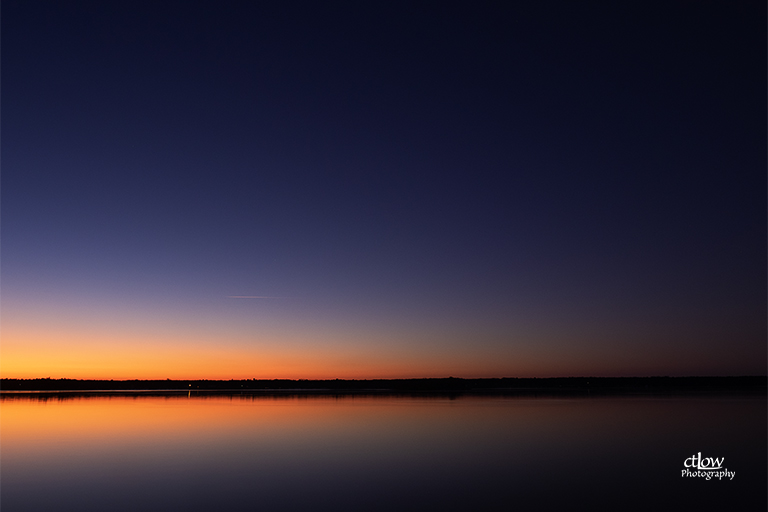Charles T. Low Photography

Blog
Technique and Flow
Techno-geek Special Edition
(breaking my usual technique-transparency
rule!)

I aim, with my general art-protocol, to keep technique transparent; I simply want people to find an image intriguing, without noticing how hard I worked for it (or didn't!), or what methods I used.
The details of this specific blog-post might interest non-photographers less, but ... you can still look at the images!
I never find painters, or sculptors, discussing their hardware in public. At musical concerts, we don't hear any discussion about instruments (or of the years of practice). And yet photographers seem to love to discuss their equipment. I prefer to emphasize art; that relegates my (very important) camera-gear to the category of tools.
An old saying goes like this: The really hard part is making it look easy.
But allow me for the present purposes to drop the façade, and to discuss technique.
If other photographers find this useful, then great. May I remind you to follow your own visions, not mine (hands off my visions!), which of course we can all do better by knowing our equipment backwards and forwards. (For example, I practice, from time to time, working my camera controls in the dark. That comes in really handy, for instance, during my early dawn work.)
Below I show one of the images which I made on that (cold) foggy morning when I made the camera-and-tripod image, above.

That composition came and went very quickly; landscape-photography occurs much more dynamically than many would think, and it helped to know my gear. For example, I had to know how to auto-focus very quickly on an off-centre subject.
Pretty well every serious art-photographer also includes some degree of editing-expertise in their repertoire. Contests will often say something like: "No editing ... beyond of course the basic histogram-expansion, saturation adjustment, sharpening ...". And none of this started suddenly with digital photography. We have simply moved the darkroom to the computer.
So this:
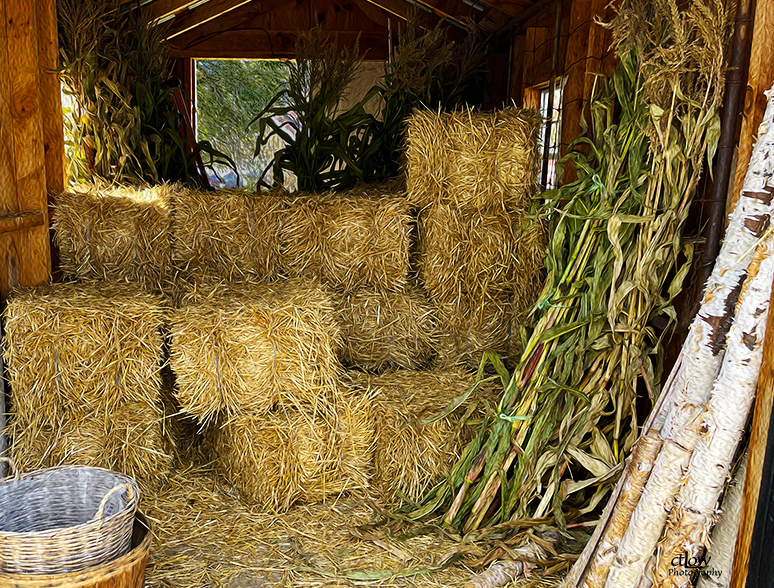
started off life like this (which I normally wouldn't show):
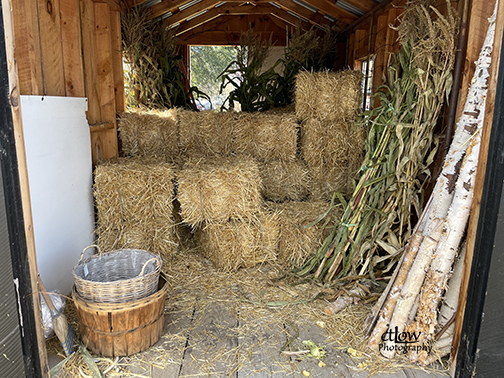
Numerous techniques enhanced the final image, including those mentioned above (histogram, etc.), as well as cropping, and the application of an oil-painting filter.
(Some visual artists object to the digital simulation of their medium, as they have the absolute right to, but ... I only ask if one likes the work.)
Another little point about that image interests me, namely that it occurred during my lunch-break at an art-show at Gemmell's Garden Centre. I made a couple of quick cellphone exposures (because use the camera you have with you
), while scarfing down some cold pizza.
The tree trunk below, a Shagbark Hickory (so my advisors tell me), presented first of all a compositional challenge. I wanted to show that amazing bark, and face-on didn't work, and aiming up the entire trunk just meant that everything got lost, so I worked out this compromise.
But then, hand-holding, what settings could I choose which would realize my artistic vision? That worked out like this: f/11, 1/125 s, ISO 800. Then, it helped to know that f/11 on my Four-Thirds sensor gives the same depth of field as f/22 on a full-frame sensor (but without the small-aperture diffraction). I use a hand-holding preset on my camera — so it helps to know how to work the presets — which puts the ISO on Auto, so I can concentrate on all of the other settings (which resulted in the 800
). Then it helps to know how high I can push the ISO without sacrificing quality — more on that below. I also used an EV of minus-1 — read more about EV-adjustment, if you like. One can get a helpful preview of the EV-effect on a digital camera, unlike with a film-camera.
I will skip a discussion of white-balance, but I do need to know about it.
I have not so far mentioned the choice of focal length, which I arbitrarily place into the category of composition
rather than of settings
, but it always matters; for the tree trunk, I chose 80 mm (equiv.), or 1.6x magnification.
And then I did all of the editing things mentioned so far (separately for the foreground and background), restricting the oil-painting filter to the background, and in addition blurred the background even further, trying to keep it complimentary with, not competitive against, the foreground.
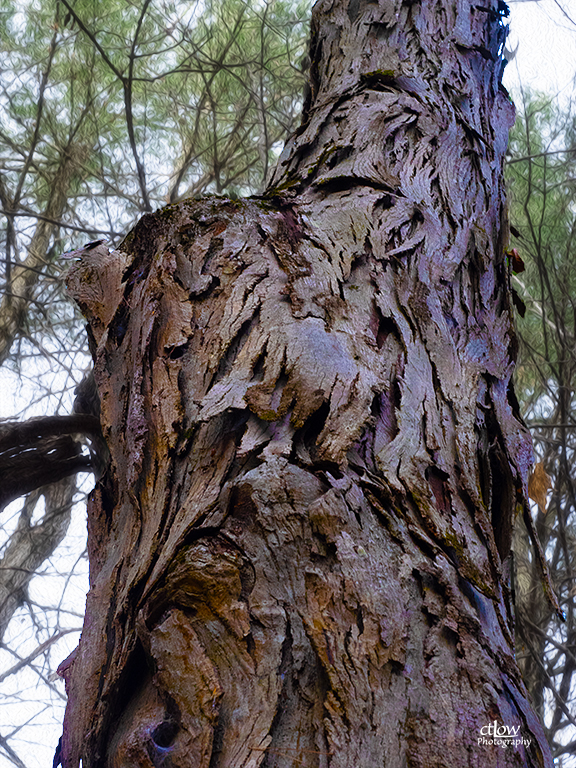
On that same photography-amble, I was waiting for my friend to photograph something which interested me less (or was it vice versa?), and noted this section of woodland, just down the trail.
Now, I teach the photography precept of not just lining up one's camera on something appealing, and then being surprised when art does not result. Nowhere does this apply more than when photographing a stand of trees. The reasons for this include binocularity, which the camera does not provide, as only one of many other factors.
So, I enjoy proving myself wrong, on occasion, and the following view into a forest, not as amorphous as I might have at first thought, continues to please me. I think that the subject comes from the pattern, the texture, and that can feel a little harder to define. Many subtle compositional elements can often come together, and sometimes we best leave them unspoken, but I will just say that I would not have made this very vertical image without the dramatic punctuation of the dark splotches all over the birch tree trunks.
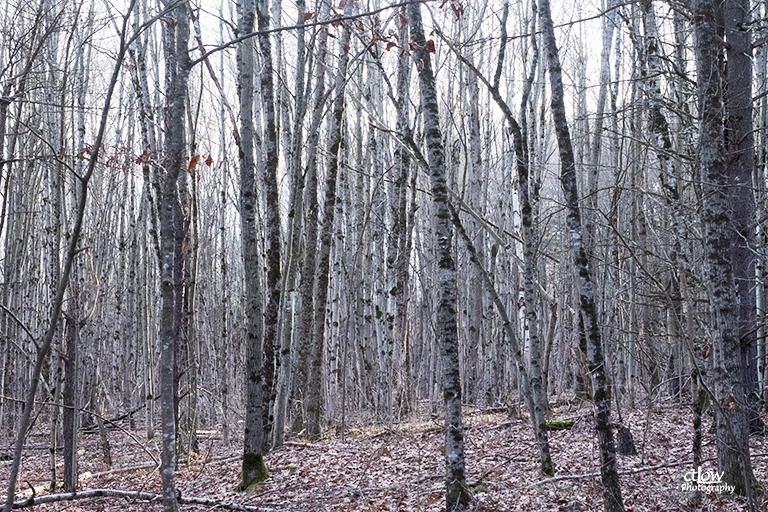
One of the technicalities of that image involves the aspect-ratio. My camera produces 3:4, vs. a perhaps more traditional photographic ratio of 2:3, meaning the ratio of the length of the short side to the long side.
So in this case, I didn't want to crop it, but made the decision to go to 2:3, so when I had finished editing, I reduced the size of the image by a different divisor in width than in height.
I squished it down vertically a little, in other words. I think it turned out well.
I also note that I hand-held the camera, for this image, and with the settings I wanted (f/11 and 1/60 s), that required an ISO of 2500, i.e. i) it was dark in there, and ii) this would not have been even possible with film. Comparing that with the camera's base-ISO (200), image degradation has certainly occurred, and for this image I propose that it doesn't matter; the viewers who would ever have even thought about it, had I not mentioned it, number roughly zero. Often, ISO does matter, and knowing when it does, and when it does not, occurs at that intersection of art and technicalities where we so often reside, but even then, it does you no good if you don't know your camera controls.
So, in the image below, of rain falling from a cloud-base at dawn, I chose an ISO of 400, closer to baseline, to prevent mottling in the large expanses of near-solid colour. That kept my shutter speed down to 1/30 s, which at high telephoto (300 mm equiv., 6x magnification) necessitated a tripod.

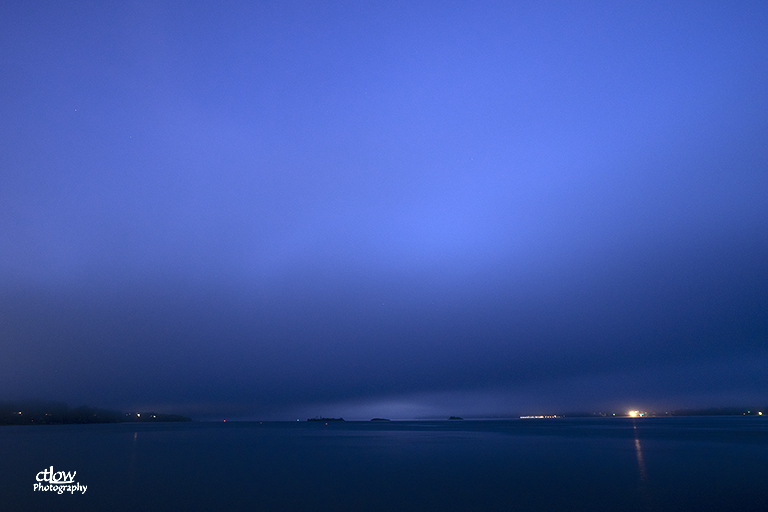
Similarly, for the image above, made in the very early dawn under cloud and fog, I kept the ISO low — 200, in this case — for identical reasons to those for the previous. I used f/8, and an exposure time of 15 s. Requiring fifteen seconds means that I had very little light; I am quite familiar with such long exposures, nowhere of course even close to hand-holdable.
Interestingly, I have a very similar one from a year or so ago in red — primarily a matter of i) cloud density, and ii) how long until the sun rose (the blue hour giving way to reds, at least in the east, as the sunrise draws nigh).
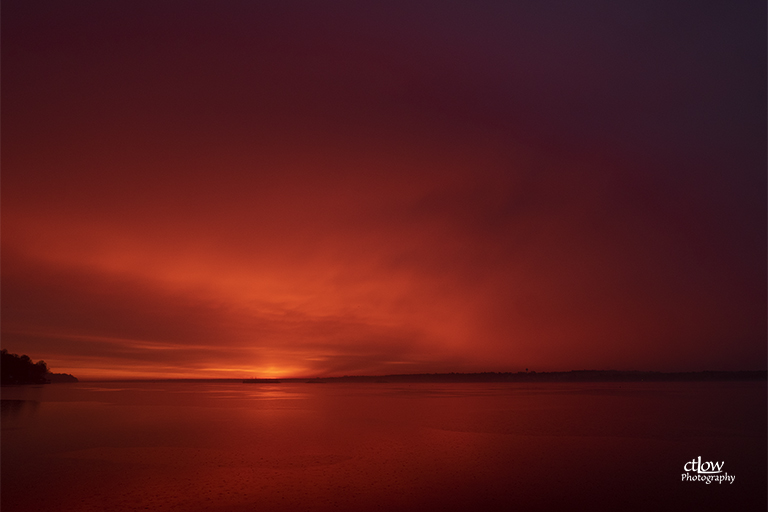
I can provide a print of any image of mine you might want, but I already have a copy of the Red Dawn one above, ready to go.
Art Matters More
-but one does have to know the technicalities of one's craft, to produce it
I can't show all of my work in these blogs, so feel free to follow me on various social media. I keep the list here (now including Mastodon, but I suggest Instagram for the most images).
Thank you all so much for reading! Kindly comment.
Subscribe
I would love it if you were to subscribe to this blog, and to refer friends.
You may wish to look through my larger portfolio. Almost everything is for sale. I favour large wall art, and also deal in books and other small items: prints, notecards, and postcards.
Charles T. Low
Photographer
Blog #87
2022-11-25
